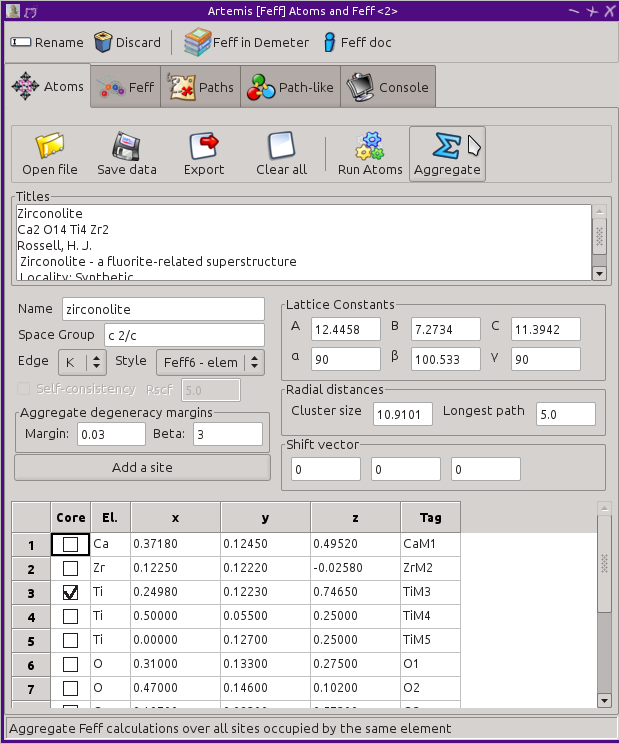Aggregate Feff calculation
If crystal data has two or more inequivalent sites occupied by the
same kind of atom, some additional functionality is enabled when one
of the inequivalent sites is selected as the absorber. As you can see
in the following screenshot, the “Aggregate”
button is available, as are controls for setting the
fuzzy degeneracy
parameters.
In the aggregate FEFF calculation, the path finder is run for each
inequivalent position containing the same central atom. The path
lists are merged together, weighted by fractional population of the
site in the unit cell, before running the check for fuzzy degeneracy.
The weighting by population fraction means that a bin of paths can be
occupied by a non-integer number of atoms.
In the example of CaZrTi2O7, there are three Ti sites. The are
8 Ti1 atoms in the unit cell and 4 each of Ti2 and Ti3. Thus half the
Ti atoms are from site 1 and a quarter each from sites 2 and 3. Each
Ti site is surrounded by 6 oxygen atoms at a variety of distances.
Ti1 has O atoms at 1.843 Å, 1.880 Å, 1.927 Å, 1.987
Å, 2.0007 Å, and 2.023 Å. Ti2 has 2 O atoms at each of
1.786 Å, 2.050 Å, 2.498 Å. Ti3 has 2 O atoms at each
of 1.975 Å, 1.877 Å, 1.975 Å. In short, the Ti K edge of
CaZrTi2O7 is a mess!
Using a bin size of 0.1 Å and combining the three sites together
weighted by their fractional populations in the unit cell, we end up
with 4 distances. There are 2.5 O atoms at 1.852 Å, 2.5 O atoms
at 1.984 Å, 0.5 O atoms at 2.050 Å, and 0.5 O atoms at 2.498
Å.
Instead of having to parameterize 12 different Ti-O distances, keeping
track of fractional populations when parameterizing the S²₀ values
for each path, the aggregate FEFF calculation requires managing
only 4 paths.
For a complete discussion of the the aggregate FEFF calculation,
see
B. Ravel, J. Synchrotron Radiat., 21,
(2014) p. 1269-1274 (DOI: 10.1107/S1600577514014982)
![[Artemis logo]](../../images/Artemis_logo.jpg)
